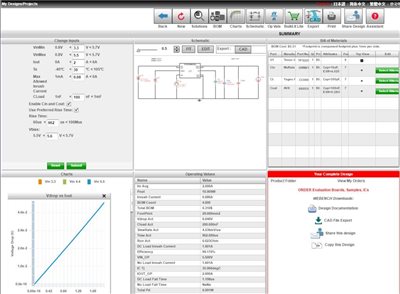Load switches are used in a wide variety of applications, from cars to phones to servers to medical devices, so it would make sense that not everyone uses their load switch the same way. The data sheet will show the performance and specifications, but it can’t capture every application. Perhaps the data sheet shows performance with an input voltage of 1.2V or 1.8V, but your application operates at 1.35V. What should you do? To know what to expect for your specific application, try using TI’s WEBENCH® tool.
Opening a load-switch design in WEBENCH
To start your design, go to the Power Designer Enabled Devices link in TI’s WEBENCH Design Center. From the list across the top, select the Load Switch option (see Figure 1). By clicking the Create button, the WEBENCH tool will open the product folder for the load switch you selected.
Figure 1: Load-switch WEBENCH device listing
Load switches with WEBENCH capabilities will have the WEBENCH widget on the right side of the product folder. Figure 2 shows the widget for the TPS22965 load switch.
Figure 2: Load-switch widget from the TPS22965 product folder
Using this widget, some of the design parameters are already entered into the tool. The left side of the widget shows the parameter names, the middle is for user entry and the right shows the range of values applicable for that specific load switch. Clicking the Open Design button starts the WEBENCH tool. The display will be similar to the one shown in Figure 3.
Figure 3: WEBENCH Designer layout
Change inputs
At the top-left corner is the Change Inputs section, as shown in Figure 4.
Figure 4: WEBENCH Designer Change Inputs section
After creating a design, the Change Inputs section allows you to go back and modify the design parameters. There are also additional options and parameters depending on the selected load switch. By changing these values, the simulated design results – schematic, graphs and operating values – are updated.
Schematic
By clicking the Schematic box, the schematic for the design will open.
Figure 5: Schematic for the created WEBENCH design
This schematic shows what the design looks like based on the design parameters entered and the load switch configuration. By using this view, you can verify the connections and components used with the load switch.
Operating values
The Operating Values section provides many calculated values that show how the device is expected to perform, taking into account all entered design parameters. Figure 6 shows an example of this section.
Figure 6: WEBENCH Designer Operating Values section
This is one of the most useful sections of the WEBENCH Designer tool, since it tells you what load-switch performance to expect for a very specific application. In-rush current, rise time, efficiency, on-resistance, and power dissipation are just a few of the results calculated. To change these values, simply enter new design parameters in the Change Inputs section. In doing so, you can see how changing the design parameters will change the load-switch behavior. For example, changing the output capacitance will affect the in-rush current for the load switch.
Adding load switches in Power Architect
Your application may have a specific start up sequence due to the different power rails of a processor or FPGA. When designing a power supply using the WEBENCH Power Architect tool, load switches can be added for power sequencing. For instructions on how to do this, please visit the WEBENCH help center.
Unique designs can lead to innovation and success in the marketplace. If you have a design that uses a load switch in a way not specified in the data sheet, use the WEBENCH tool to model the performance and stay a step ahead!
As always, if you need additional support with your design, feel free to post your question on our TI E2E™ Community Load Switches and Power Path Protection forum.
Additional resources
- Use the TI WEBENCH tool to model load-switch behavior for various applications.
- Learn more about load switches by downloading these application reports:
- Check out these load-switch blogs for more information:
- Watch the video, “Replacing discrete MOSFETs with load switches.”





